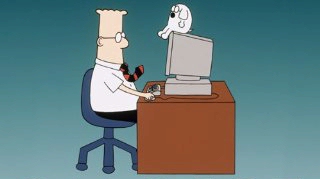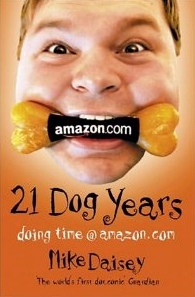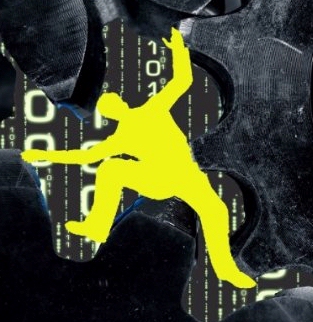
There was a startling announcement on Monday. An Amazon employee is selling a book about their life at the company. But if you purchased it as a Kindle ebook, he’d also mail you a free print version of the same book! It’s the first time I’ve seen a print book relegated to the “bonus” give-away when purchasing a digital ebook — and it turns out he’s not the only former Amazon employee who’s come up with some new twists on Kindle ebooks…
This offer was described at unusualPromotion.com, and a press release claims it “marks the beginning of a turning point in the Book 2.0 evolution.” But there’s at least three other Amazon employees who have also done some extra thinking about books and ebooks – and the ways that we’ll find them!

21 Dog Years: Doing Time @ Amazon.com
In 2002, Mike Daisey released a 240-page memoir about his own time at Amazon. In fact, he’d already created a one-man theatrical show in Seattle about his experiences, according to a review by Library Journal, which jokes that Amazon may be haunted by their decision to hire Daisey back in 1998. (Daisey writes that “Amazon and I started in Seattle at about the same time,” and addds that “To give you an idea of how clueless I was, I had originally assumed that Amazon was a lesbian Internet bookstore, owing to the historical origins of the word Amazon along with the company’s reputation for being ‘progressive.'”) Daisey appears to have been one of the first few hundred employees at Amazon, and his book is a fast-paced and funny read, with lots of very entertaining gossip. Here’s how he remembers a presentation for potential new Amazon employees.
“The four Amazonians who came to speak with us had the clearest, cleanest skin that I’d ever seen… I would never see those people again in my entire time at Amazon. I assume they worked for a black-ops section that specialized in providing fake employees who are startlingly sharp, attractive, and painfully fit.
“We settled back and they began to talk about Linux tools and server uptime, and I suddenly realized that these people were geeks. Serious computer geeks who looked and smelled great…from the way the sexy tech workers talked about Amazon.com, it appeared I’d really missed the boat….
“These tech-savvy, attractive, and well-spoken workers appeared blissfully happy… The opportunity to be near them, surrounded by their coolness and learning from them while being paid, sounded like heaven in itself. If I couldn’t be a geek, at least I could be in their company. And what a company! Though I hadn’t known who they were until that day, I was convinced they were making history… I had a vague sense of riches, of future glory…”
But soon he’s talking about his inevitable disillusionment. (“Doing Time @ Amazon.com” was the book’s original subtitle, though it was later apparently changed to “A Cube-Dweller’s Tale.”) Library Journal calls his book “an eye-opening testament as to how truly dysfunctional a dot-com can get,” noting that Daisey describes his work environment as “gothic” and spills the beans on some unusual phone calls that came in to Amazon’s customer service. And they acknowledge that his insider stories about life at Amazon are all “quite funny.”
Interestingly, that book isn’t available as an e-book on Amazon’s Kindle — though you can buy it as an audiobook.

Burning the Page
This book just came out in April, and it was written by Jason Merkoski, who was actually the program manager for the Kindle on the day that it launched. I thought it was fascinating memoir with some interesting insights into the future of reading. But more importantly, the author came up with some clever new ebook tricks to help make his book more appealing to Kindle owners.
On Twitter and Facebook, Merkoski revealed part of “the brave new world of what I call ‘Reading 2.0′”. At the end of the first chapter of “Burning the Pageâ€, he’d included a link to a social app offering his readers a way of connecting to not only the author, but to other readers — plus “surprises all along the way.” He promised it would be a combination of a virtual book club, offering a chance to interact with the book’s author as he became “a thoughtful friend who brings you special notes and treats.” Each chapter ended with a new link, and when readers clicked on it, there was always another new surprise waiting. Once it was a link to an unannounced bonus chapter, and another time it was a personalized digital autograph. And Merkoski promised that when you finished reading his book, you’d receive a personalized message from the author himself.
tinyurl.com/BurningTheBook

Amazonia: Five Years at the Epicenter of the Dot.Com Juggernaut
James Marcus remembers interviewing for a job in “a low, inauspicious building south of the downtown, next to a barbecue joint whose vinegar-scented fumes I could smell the moment I hit the sidewalk.” Marcus was Amazon employee #55, back when Amazon’s yearly sales were just $16 million a year, and he provides “a captivating, witty account of how the fledgling e-retailer transformed itself,” according to Publisher’s Weekly. At the age of 37, he was the oldest person in the room when he arrived at what he describes as a book warehouse with offices, and the book opens with a fascinating description of how ambitious Jeff Bezos had likeably interviewed him. (“He had none of Bill Gates’s pasty paranoia…”) Marcus even tours the warehouse — snooping on individual customer orders. “Forget heterosexual, plain-vanilla porn (of which there was a great deal)… In cyberspace, I could see, there was no love that dare not speak its name…”
It’s an inspiring read, because even back then he could see that Amazon was intent on changing the world, and “Their sense of having grabbed history by the horns was almost palpable.” Publisher’s Weekly even noted a kind of nostalgia in his book for the early days of Amazon, as Marcus writes about their warehouse across from the world headquarters of Starbucks and the exhiliaration they seemed to feel. “It made them slightly giddy and enormously tired.”
And as he walks his future co-workers back to their offices, “The breeze had shifted and the barbecue fumes were again in evidence.”

Inside the Giant Machine
“Behind Amazon’s quirky smile logo lurks a cold and calculating giant machine,” claims the book’s description, promising an e-book filled with poetry that “makes us feel the vitality of the Hi-Tech worlds of California and Seattle.” The first section of “Inside the Giant Machine” is an e-mail the author had sent in 2002 to his friends, describing a late-night success at his own startup company. That company’s success leads to a merger, after which “we ended up with two VPs of Technology — which was one too many,” and soon he’s also looking for a new job in Seattle. This is the book that was “developed” from blog posts, though at times it feels like it might’ve been inspired (if not modeled) after some of the earlier books by Amazon employees.
In fact, one of the author’s most interesting revelations is that when he was hired Amazon actually mailed him copies of Daisey’s book “21 Dog Years: Doing Time @ Amazon.com” and James Marcus’s
“Amazonia: Five Years at the Epicenter of the Dot.Com Juggernaut” (along with three books about Seattle). This book was was written using a pseudonym (“Kalpanik S.”),so there’s no way of knowing for sure that it’s really by an Amazon employee. But he does sound like a true “Amazonian” when he writes that Amazon founder Jeff Bezos “sincerely believed that his cult was changing the world and I wanted to be part of this revolution, and change the world!”
It’s a short book — when I first bought it in 2011, the print edition was just 128 pages, and at times it felt a little bit skimpy. (The last 10% was just “back matter” — copyrights, “works cited,” a selection of “acclaim” for the book, and a list of the author’s other books (including an excerpt). There was also a “color interior” paperback edition with “approximately 80 color photographs, including several panoramic shots of Seattle!” I notice that the new version on sale today comes in at 220 pages.
But at least one reviewer at Amazon.com noticed the same thing that I did: that the book itself has a higher-than-usual number of typos. (Example?” Amazon’s young, sharp minds still want you prove to yourself to them.”) I was intrigued by the chapter titles (like “The hacker who loved me” and “things start to fall apart”), and some of his photographs (like the Seattle skyline) look very attractive on the Kindle’s black and white screen. But sometimes it felt like the author just re-published some of his old e-mails to friends.
I asked myself if I should ultimately see that as a bug or a feature. You could argue that it makes the book feel more like one man’s personal story — and it’s genuinely fun to read the moment when the former Amazon employee has a revelation, that “suddenly publishing a book was easily within my reach.
“All I needed to do was combine those various pieces, fill in the gaps, polish the material, and hire an editor!”
There were a few lines that made me laugh out loud, but the author’s first chapter about his startup also rises to a poignant conclusion. “We want to change the world, though, and that is never easy. The world is usually very reluctant to change, especially at the pace startups want it do so.”
And then another future book-author headed off for his fateful two-day job interview at Amazon.com…